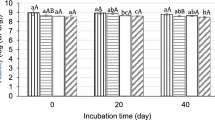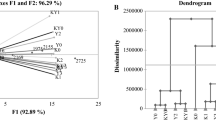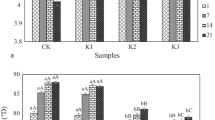Abstract
This study aims to reveal the effect of each of prominent lactic acid bacteria (LAB) in the microbiota of kefir grain on the chemical and biochemical properties of kefir and especially, the formation of the volatile aroma compound (VAC) profile. Thus, fermented samples were produced in milk using single strains of Lactobacillus kefiranofaciens (LKF), Lentilactobacillus parakefiri (LP) and Lentilactobacillus kefiri (LK), as well as two control samples using kefir grain (TK) and commercial kefir culture (CK). In the samples, the change in LAB amounts, physicochemical (pH, titration acidity), rheological and chemical properties (organic acid, sugar and volatile flavour compound content) were investigated. The results showed no significant difference between LAB numbers and physicochemical properties of the samples. The LK, the LP and the LKF strains, respectively, were observed more activity in acetic acid production, citrate and lactose consumption. In VAC profiles, the LKF strain was associated with hexanol, 2-octanol, and octanal and LK with ethyl octanoate, ethyl hexanoate, acetaldehyde and geraniol. The LP strain was characterized by aldehydes including heptanal, nonanal and decanal. Thus, the L. parakefiri strain was highlighted in terms of the desired aroma profile. These results provide a clearer understanding of possible metabolic pathways and functions of the prominent strains in the kefir grain.





Similar content being viewed by others
Data availability
Data will be made available on reasonable request.
Code availability
Not applicable.
References
Kok-Tas T, Ekinci FY, Guzel- Seydım ZB (2021) Identification of microbial flora in kefir grains produced in Turkey using PCR. Int J Dairy Technol 65:126–131
Bengoa AA, Iraporda C, Garrote GL, Abraham AG (2019) Kefir micro- organisms: their role in grain assembly and health properties of fermented milk. J Appl Microbiol 126:686–700
Vardjan T, Lorbeg PM, Rogelj I, Majhenič AČ (2013) Characterization and stability of lactobacilli and yeast microbiota in kefir grains. J Dairy Sci 96:2729–2736
Miguel MGDCP, Cardoso PG, De Assis LL, Schwan RF (2010) Diversity of bacteria present in milk kefir grains using culture-dependent and culture-independent methods. Food Res 43:1523–1528
Delgado-Fernández P, Corzo N, Lizasoain S, Olano A, Moreno FJ (2019) Fermentative properties of starter culture during manufacture of kefir with new prebiotics derived from lactulose. Int Dairy J 93:22–29
Kim DH, Kim H, Seo KH (2019) Microbial 622 composition of Korean kefir and antimicrobial activity of Acetobacter fabarum DH1801. J Food Safety 40:e12728
Łopusiewicz Ł, Drozłowska E, Siedlecka P, Mężyńska M, Bartkowiak A, Sienkiewicz M, Zielinska-Blizniewska H, Kwiatkowski P (2019) Development, characterization, and bioactivity of non-dairy kefir-like fermented beverage based on flaxseed oil cake. Foods 8:544
García-Quintáns N, Blancato VS, Repizo GD, Magni C, López P (2008) Citrate metabolism and aroma compound production in lactic acid bacteria. In: Mayo B, López P, Pérez-Martínez G (eds) Molecular aspects of lactic acid bacteria for traditional and new applications. Research Signpost India, Thiruvananthapuram, pp 65–88
Simova E, Simov Z, Beshkova D, Frengova G, Dimitrov Z, Spasov Z (2006) Amino acid profiles of lactic acid bacteria, isolated from kefir grains and kefir starter made from them. Int J Food Microbiol 107:112–123
Rattray FP, O’connell O (2011) Fermented milks kefir. In: Fukay JW (ed) Encyclopedia of dairy sciences. Academic Press, San Diego, pp 518–524
Nejati F, Junne S, Neubauer P (2020) A big world in small grain: a review of natural milk kefir starters. Microorganisms 8:192
AOAC (2000) Association of official analytical chemistry official methods of analysis of the association of analytical in chemists, 17th edn. AOAC International, Washington, USA
Holt JG, Krieg NR, Sneath PHA, Staley JT, Williams ST (1994) Bergey’s manual of determinative bacteriology, 9th edn. Williams and Wilkins, Baltimore, USA, pp 757–787
Güzel-Seydim ZB, Seydim AC, Greene AK, Bodine AB (2000) Determination of organic acids and volatile flavor substances in kefir during fermentation. J Food Compost Anal 13:35–43
Anonymous (2009) Turkish Food Codex Communiqué on Fermented Milk Products (Communiqué Number: 2009/25) Official newspaper. 16.02.2009, Issue 27143, http://www.kkgm.gov.tr/TFC/2001–21.html. Accessed on 13.05.2020
Nambou K, Gao C, Zhou F, Guo B, Ai L, Wu ZJ (2014) A novel approach of direct formulation of defined starter cultures for different kefir-like beverage production. Int Dairy J 34:237–246
Yovanoudi M, Dimitreli G, Raphaelides SN, Antoniou KD (2013) Flow behaviour studies of kefir type systems. J Food Eng 118:41–48
Ahmed Z, Wang Y, Anjum N, Ahmad A, Khan ST (2013) Characterization of exopolysaccharide produced by Lactobacillus kefiranofaciens ZW3 isolated from Tibet kefir–Part II. Food Hydrocoll 30:343–350
Breuer U, Harms H (2006) Debaryomyces hansenii—an extremophilic yeast with biotechnological potential. Yeast 23:415–437
Endo A, Okada S (2007) Lactobacillus farraginis sp. nov. and Lactobacillus parafarraginis sp. nov., heterofermentative lactobacilli isolated from a compost of distilled shochu residue. Int J Syst Evol Micr 57:708–712
Kandler O, Kunath P (1993) Lactobacillus kefir sp. nov., a component of the microflora of kefir. Syst Appl Microbiol 4:286–294
Li L, Ma Y (2018) The effect of soluble saccharides on the activity of key enzymes linked to methyl ketone synthesis in Lactococcus lactis. CyTA-J Food 16:325–330
Di Cagno R, Filannino P, Gobbetti M (2017) Lactic acid fermentation drives the optimal volatile flavor-aroma profile of pomegranate juice. Int J Food Microbiol 248:56–62
Papagora C, Roukas T, Kotzekidou P (2013) Optimization of extracellular lipase production by Debaryomyces hansenii isolates from dry-salted olives using response surface methodology. Food Bioprod Process 91:413–420
Chen C, Zhao S, Hao G, Yu H, Tian H, Zhao G (2017) Role of lactic acid bacteria on the yogurt flavour: a review. Int J Food Prop 20:S316–S330
Sharma A, Sharma P, Singh J, Singh S, Nain L (2020) Prospecting the potential of agroresidues as substrate for microbial flavor production. Front Sustain Food Syst 4:18
Walsh AM, Crispie F, Kilcawley K, O’Sullivan O, O’Sullivan MG, Claesson MJ, Cotter PD (2016) Microbial succession and flavor production in the fermented dairy beverage kefir. Msystems 1:00052–00116
Lee LW, Liu X, Wong WSE, Liu SQ (2017) Effects of sucrose monopalmitate (P90), Tween 80 and modified starch on coffee aroma retention and release in coffee oil-based emulsions. Food Hydrocoll 66:128–135
Mantzourani I, Kazakos S, Terpou A, Mallouchos A, Kimbaris A, Alexopoulos A, Bezirtzoglou E, Plessas S (2018) Assessment of volatile compounds evolution, antioxidant activity, and total phenolics content during cold storage of pomegranate beverage fermented by Lactobacillus paracasei K5. Fermentation 4:95
Eder M, Sanchez I, Brice C, Camarasa C, Legras JL, Dequin S (2018) QTL mapping of volatile compound production in Saccharomyces cerevisiae during alcoholic fermentation. BMC Genomics 19:166
Magalhães KT, Dragone G, De Melo Pereira GV, Oliveira JM, Domingues L, Teixeira,Almeida e Silva JB, Schwan RF JA (2011) Comparative study of the biochemical changes and volatile compound formations during the production of novel whey-based kefir beverages and traditional milk kefir. Food Chem 126:249–253
Vedamuthu ER (2006) Starter cultures for yogurt and fermented milk. Manufacturing yogurt and fermented milks. Blackwell, Iowa, pp 89–116
Kaminarides S, Stamou P, Massouras T (2007) Changes of organic acids, volatile aroma compounds and sensory characteristics of Halloumi cheese kept in brine. Food Chem 100:219–225
Carunchia-Whetstine ME, Karagul-Yuceer Y, Avsar YK, Drake MA (2003) Identification and quantification of character aroma components in fresh Chevre- style goat cheese. J Food Sci 68:2441–2447
Dan T, Wang D, Wu S, Jin R, Ren W, Sun T (2017) Profiles of volatile flavour compounds in milk fermented with different proportional combinations of Lactobacillus delbrueckii subsp. bulgaricus and Streptococcus thermophiles. Molecules 22:1633
Dragone G, Mussatto SI, Oliveira JM, Teixeira JA (2009) Characterization of volatile compounds in an alcoholic beverage produced by whey fermentation. Food Chem 112:929–935
Ledauphin J, Guichard H, Saint-Clair JF, Picoche B, Barillier D (2003) Chemical and sensorial aroma characterization of freshly distilled calvados. 2. Identification of volatile compounds and key odorants. J Agric Food Chem 51:433–442
Belviso S, Giordano M, Dolci P, Zeppa G (2011) Degradation and biosynthesis of terpenoids by lactic acid bacteria isolated from cheese: first evidence. Dairy Sci Technol 91:227
Funding
This work was supported by Süleyman Demirel University Scientific Research Projects Management Unit [Grant No. FYL-2019-7079].
Author information
Authors and Affiliations
Contributions
All authors contributed to the conception and design of the experiments, their performance, interpretation of the obtained results, writing of the article and revising it. All authors have approved the final version of the manuscript.
Corresponding author
Ethics declarations
Conflict of interest
The authors have no conflicts of interest to declare that are relevant to the content of this article.
Ethics approval
Not applicable.
Consent to participate
Not applicable.
Consent for publication
Not applicable.
Additional information
Publisher's Note
Springer Nature remains neutral with regard to jurisdictional claims in published maps and institutional affiliations.
Rights and permissions
About this article
Cite this article
Duran, F.E., Özdemir, N., Güneşer, O. et al. Prominent strains of kefir grains in the formation of volatile compound profile in milk medium; the role of Lactobacillus kefiranofaciens subsp. kefiranofaciens, Lentilactobacillus kefiri and Lentilactobacillus parakefiri. Eur Food Res Technol 248, 975–989 (2022). https://doi.org/10.1007/s00217-021-03936-2
Received:
Revised:
Accepted:
Published:
Issue Date:
DOI: https://doi.org/10.1007/s00217-021-03936-2




